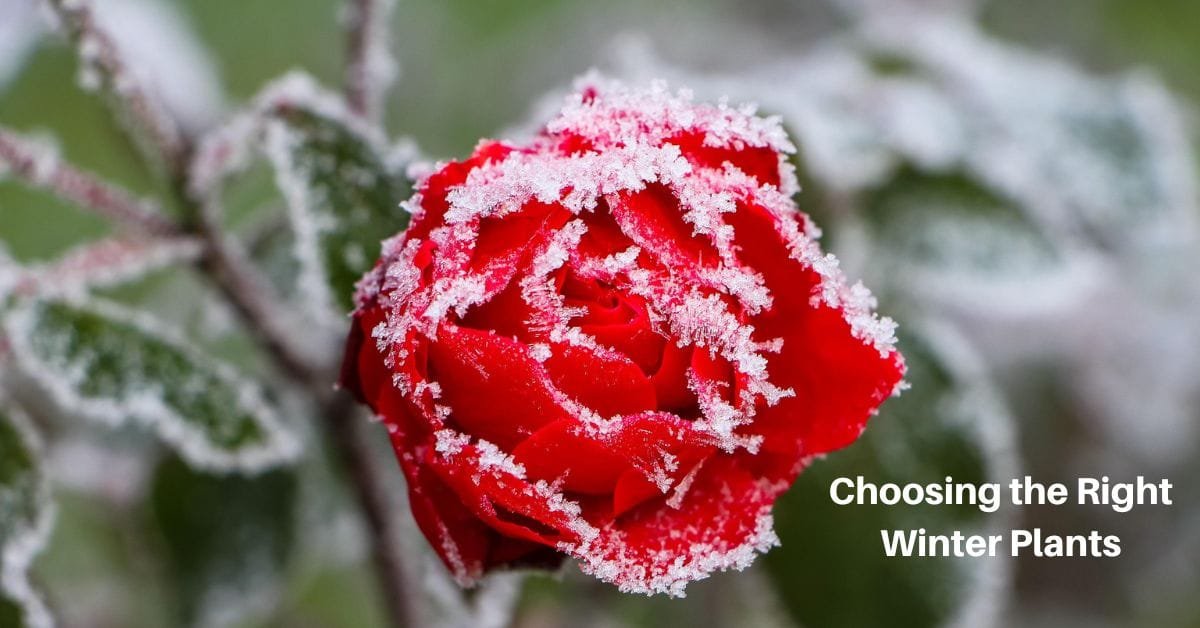If you want a thriving garden, you don’t have to wait for the temperature to warm up. With the right plant choices and a little preparation, you can have a resilient and beautiful garden even through harsh winters. Evergreens can provide structure, perennials can return stronger each year, and cold-hardy vegetables can extend your growing season. It all comes down to selecting the right plants!
The secret to winter gardening success starts with knowing your local climate. If you understand your hardiness zone and choose plants that can withstand freezing temperatures, you’ll create a landscape that stays beautiful and functional even in the coldest months. Let’s explore the best winter plants for frosty climates and how to care for them.
Understanding Your Hardiness Zone
When selecting plants for a winter garden, the first step is understanding your region’s USDA Hardiness Zone. This system categorizes different areas based on their average minimum winter temperatures, helping gardeners determine which plants will survive year-round. The zones range from 1 (the coldest, below -50°F) to 13 (the warmest, above 60°F).
To find your zone, you can check the USDA Hardiness Zone map or use online gardening tools. The closer you are to zones 1-6, the more likely your winters will have harsh freezes, deep frosts, and heavy snow. In contrast, zones 7-9 may experience milder winters, where many plants can survive without much intervention.
Why Hardiness Matters
Choosing plants suited to your zone is essential for successful winter gardening. Some plants that thrive in warmer climates may not withstand extended freezes or frost heaving (when plants are pushed out of the soil due to the freezing and thawing cycle). On the other hand, certain plants can tolerate extreme cold and even flower in winter, providing color and life when most plants go dormant.
Even within the same hardiness zone, microclimates in your yard can affect plant survival. Areas near buildings, fences, or large rocks can retain heat and provide extra warmth, but open spaces exposed to strong winds might be colder than the zone’s average temperature.
Cold-Hardy vs. Frost-Tender Plants
- Cold-hardy plants can withstand subzero temperatures and often remain green or even bloom in winter.
- Frost-tender plants require protection, such as mulch, burlap wraps, or cloches, to survive the cold.
How to Use This Information
- Select plants that are at least one zone colder than your area for the best survival chances.
- Group cold-sensitive plants together so you can easily cover them in extreme weather.
- Place delicate plants near structures for added warmth and protection.
Understanding your hardiness zone is the foundation for choosing the right winter plants. With this knowledge, you can plan a garden that stays vibrant and healthy, even through snow and ice.
Best Plants for Winter Gardens in Cold Climates
Once you understand your hardiness zone, you’ll want to select plants that will thrive in your winter landscape. Many plants can survive the cold and even thrive in freezing temperatures, providing color, texture, and even blooms when most of the garden is dormant.
Evergreens: Year-Round Structure and Color
Evergreens are the backbone of a winter garden, offering lush foliage and structure when deciduous plants shed their leaves.
- Conifers (Pine, Spruce, Fir, Juniper, Cedar) – These trees and shrubs are exceptionally cold-hardy, with many varieties surviving in Zones 2-6. They provide windbreaks, shelter for wildlife, and a rich green backdrop throughout the cold months.
- Holly (Ilex spp.) – Hardy in Zones 5-9, holly is known for its glossy green leaves and bright red berries, which persist through winter and attract birds.
- Boxwood (Buxus spp.) – A classic evergreen shrub, boxwood holds its shape and color well, even under snow, making it a great choice for Zones 4-9.
Winter-Flowering Plants: Adding Color to the Cold
Most flowering plants go dormant in winter, but a few are cold-tolerant enough to bloom despite the freezing temperatures. Some great examples are:
- Winter Jasmine (Jasminum nudiflorum) – This hardy vine produces small yellow flowers in late winter to early spring and survives in Zones 6-10.
- Hellebores (Helleborus spp.) – Also known as the Lenten Rose, these shade-loving perennials flower as early as January or February, often while snow is still on the ground. They’re hardy in Zones 3-9.
- Witch Hazel (Hamamelis spp.) – This deciduous shrub produces fragrant, spidery flowers in late winter. It grows well in Zones 3-8 and adds an unusual element to a winter garden.
Cold-Hardy Perennials: Reliable Survivors
Certain perennials die back in winter but reemerge in spring, making them excellent choices for cold climates.
- Sedum (Stonecrop) – These drought-resistant succulents have a unique winter structure. Some varieties, like ‘Autumn Joy,’ develop dried flower heads that are attractive even when covered with snow.
- Ornamental Grasses (Miscanthus, Switchgrass, Little Bluestem) – Many grasses remain upright in winter, adding movement and texture to the landscape while also providing habitat for birds and small animals.
- Coral Bells (Heuchera spp.) – Though typically grown for their foliage, some varieties retain their color throughout winter, especially in Zones 4-9.
Cold-Tolerant Vegetables and Herbs
For gardeners who want to continue growing edible plants during winter, several vegetables and herbs can withstand frost and even snow.
- Kale (Brassica oleracea) – This nutrient-dense green actually tastes sweeter after frost and can grow in temperatures as low as 20°F (-6°C).
- Brussels Sprouts (Brassica oleracea var. gemmifera) – These cold-hardy vegetables can survive into winter and even improve in flavor with exposure to cold.
- Thyme and Sage – Many woody herbs survive winter, especially if you give them some protection from harsh wind and snow.
Layering Plants for a Resilient Winter Garden
A well-planned winter garden should have a mix of evergreens, perennials, ornamental grasses, and flowering plants to maintain interest and structure. Consider planting in layers, combining tall trees and shrubs with lower-growing perennials and ground cover to create a visually dynamic winter landscape.
With the right plant selection, even the harshest winter garden can be full of life and color when much of nature is dormant.
Protecting Winter Plants from Extreme Cold
Even the most cold-hardy plants can struggle when winter conditions become too extreme. Frost, heavy snow, and icy winds can damage plants, while freeze-thaw cycles can cause soil to heave, exposing roots to the cold. Taking proactive steps to protect your garden will help ensure your plants emerge healthy when spring arrives.
Mulching: Insulation for Roots
Mulch is one of the simplest and most effective ways to protect plant roots from freezing temperatures. A 2-4 inch layer of mulch helps regulate soil temperature, prevents moisture loss, and reduces soil heaving.
- Best materials for winter mulch: Shredded bark, straw, pine needles, or even fallen leaves.
- When to apply: Wait until after the first hard frost to prevent pests from burrowing under the mulch.
For perennials and vegetables, mulch also acts as a protective blanket, allowing some plants to overwinter successfully.
Wrapping and Covering Plants
Tender shrubs, young trees, and certain perennials benefit from extra protection during harsh winter months.
- Burlap Wrapping: Wrapping sensitive plants like young evergreens or roses in burlap shields them from drying winds and sunscald (damage from winter sun reflecting off snow).
- Floating Row Covers: Lightweight fabric covers can protect cold-season vegetables and flowering shrubs from frost damage while allowing airflow.
- Cloche or Cold Frame: Small individual covers (like plastic domes or glass enclosures) can extend the growing season for winter vegetables.
Protecting Trees and Shrubs from Snow and Ice
Heavy snow and ice can cause branches to snap under the weight, especially for trees with thin or brittle branches.
- Tie Up Branches: For multi-stemmed shrubs like arborvitae, loosely tying the branches together can help prevent splitting.
- Knock Off Heavy Snow: Gently brush off accumulated snow with a broom to prevent excess weight from damaging plants.
- Avoid Using Rock Salt Near Plants: Salt used for de-icing can seep into the soil, damaging roots. Use sand or pet-safe ice melt alternatives instead.
Watering During Winter
Even though plants are dormant in winter, watering before the ground freezes is critical for survival—especially for newly planted trees and shrubs.
- Why it matters: Cold winds and dry winter air can dehydrate evergreens, leading to winter burn.
- Best practice: Deep water your plants before the first hard freeze so they have enough moisture stored in their roots.
Dealing with Freeze-Thaw Cycles
One of the biggest winter threats to plants is fluctuating temperatures, which can cause soil to heave and expose roots to the cold.
- How to prevent it: A thick layer of mulch and well-drained soil can minimize soil movement.
- What to do if plants heave: If you notice a plant’s roots pushed above ground, gently press it back into the soil and reapply mulch.
By taking these protective measures, your winter garden will survive the season and thrive when spring returns.
Planning for Spring: Maintaining and Transitioning Winter Plants
Winter gardening focuses on survival, but proper care during the colder months also ensures that your plants thrive when warmer temperatures return. Monitoring your plants, making small adjustments, and preparing for the seasonal transition will set your garden up for success in the spring.
Inspecting Your Garden During Winter
Winter isn’t just a waiting game—you should check on your plants periodically to address any potential issues.
- Look for signs of stress: Wilting, discoloration, or dry, brittle foliage can indicate dehydration or windburn, especially in evergreens.
- Check for frost heaving: If you notice exposed roots, carefully press the plant back into the soil and reapply mulch.
- Watch for pests: Rabbits, deer, and rodents often seek food in winter gardens. Protect tree trunks with hardware cloth or plastic tree guards, and avoid excessive mulch near the base of shrubs, which can attract rodents.
Pruning and Winter Maintenance
Winter is an ideal time for pruning certain trees and shrubs, as plants are dormant and less susceptible to stress or disease transmission.
- What to prune in winter: Deciduous trees, fruit trees, and summer-blooming shrubs like hydrangeas (depending on the variety).
- What to avoid pruning: Early spring bloomers like lilacs and forsythia should be pruned after they bloom. Also, avoid pruning plants with winter berries; the berries are an important food source for birds!
- Remove damaged branches: If ice or snow has caused broken limbs, prune them cleanly to prevent disease.
Preparing for Spring Growth
Even before temperatures rise, small steps can jump-start your garden and give winter plants a smooth transition into the growing season.
- Gradually remove winter protection: As spring approaches, start pulling back mulch from perennials and removing burlap wraps from shrubs. Do this slowly, so plants can adjust to increasing light and temperatures.
- Fertilizing after dormancy: Don’t fertilize too early—plants still need to stay dormant until consistent warmth returns. Early spring is the best time to add compost or slow-release fertilizers to encourage strong growth.
- Dividing and transplanting: Many perennials benefit from being divided right as they emerge in early spring, giving them more room to grow.
The Reward of a Well-Cared-For Winter Garden
Caring for a garden during winter takes some effort, but the rewards are worth it! When spring arrives, your perennials will return stronger, shrubs will burst into bloom, and your landscape will flourish without the setbacks caused by cold stress.
By selecting hardy plants, using proper protection, and following seasonal maintenance practices, you’ll enjoy a resilient, thriving garden year-round—even in the coldest winters.









